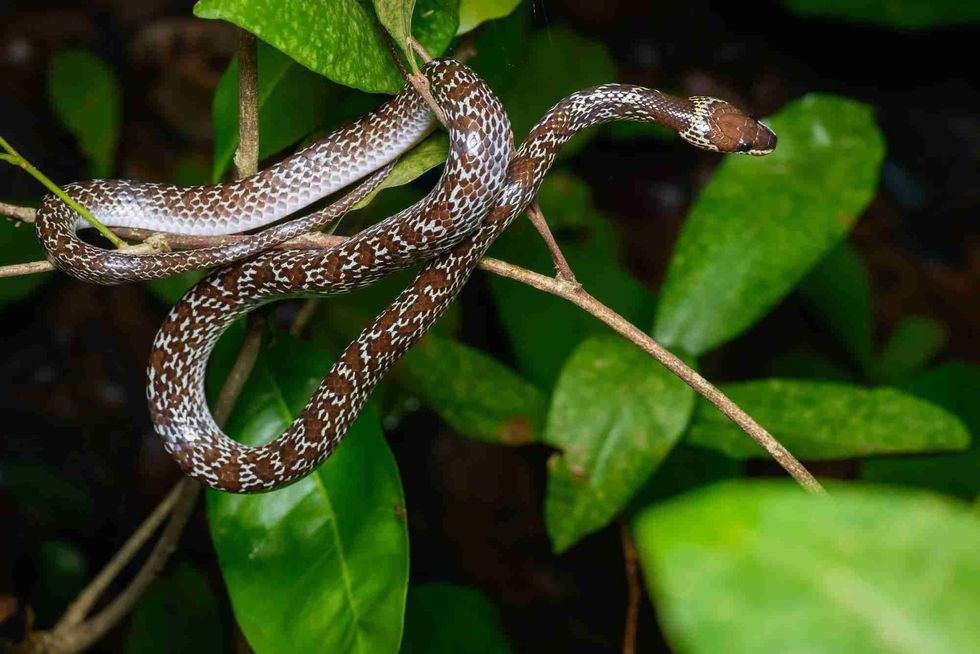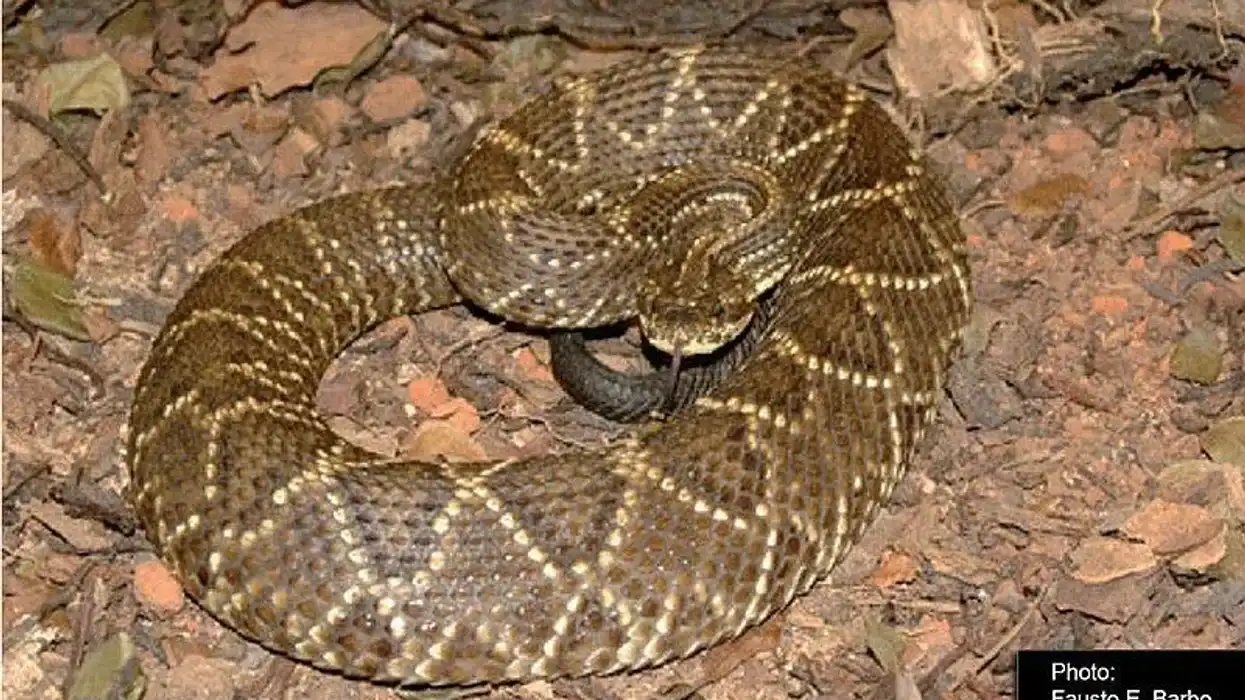The common wolf snake is anything but common! The coloration of the Lycodon capucinus wolf snake has evolved to help these animals survive underground and on the jungle floor.
This snake's typical hues are reddish-brown, jet black, or dark gray with white or pastel yellow speckles, spots, and dots distributed across the body. Lycodon capucinus snakes have a striking white coloration around the neck as well. Albino-colored snakes are quite unusual among this snake species.
For excavating in soft or sandy terrain, the snout of the Lycodon capucinus is duck-bill curved. Their front teeth are larger, yet they do not use them to inject venom.
There is so much to know and learn about the common wolf snake! You can read all about it down below or discover new animal friends from a plethora of species. Check out some cool facts on this animal, and many more like it such as the Kenai Peninsula wolf and king rat snake.
Common Wolf Snake Interesting Facts
What type of animal is a common wolf snake?
The common wolf snake (Lycodon aulicus) is a type of snake.
What class of animal does a common wolf snake belong to?
The common wolf snake (Lycodon aulicus) belongs to the class of reptiles.
How many common wolf snakes are there in the world?
Although the common wolf snake (Lycodon capucinus) is widespread across its habitat, no population estimates are available.
Where does a common wolf snake live?
The common wolf snake (Lycodon capucinus) live in the woods. The Indo-Australian Archipelago is home to the Lycodon capucinus. The common wolf lycodon, sometimes known as the Indian wolf snake, is a nonvenomous snake observed throughout Southeast Asia and Thailand.
What is a common wolf snake's habitat?
Tropical rainforests, gardens, plantations, and urban and suburban environments are all home to Lycodon capucinus snakes. In addition, the mild venomous common wolf snake (Lycodon capucinus) can be found in various habitats including open forests, dense forests, rocky terrain, and human settlements.
During the day, these snakes stay hidden and climb trees and rocks in a quest to find prey at night.
Who do common wolf snakes live with?
These reddish-brown Lycodon capucinus wolf snakes are isolated and commonly active at night. This is similar to most other snakes, most of whom only hunt at night to evade predators and capture prey.
How long does a common wolf snake live?
The average longevity of this Indian snake that is common in Thailand, Asia is around 10 years. This is relatively long in terms of lifespan since many other snakes die much sooner.
How do they reproduce?
Female snakes of the common wolf snake (Lycodon capucinus) species may be bigger than the male snake species. Before the monsoons, they mate and lay 3-11 eggs in December to January in South India and March to July in the north part of India.
The hatchlings are 5.5–8 in (13.9–20.3 cm) long when the eggs hatch in September or October.
What is their conservation status?
Common wolf snake (Lycodon capucinus) snakes found in Southeast Asia, mainly India and Thailand have a conservation status as Least Concern by IUCN, same as the horned viper.
Common Wolf Snake Fun Facts
What do common wolf snakes look like?
The common wolf snake (Lycodon capucinus) has a tiny, flat head that is only slightly wider than the neck. They also have a mandible with two to three fangs on each end and a succession of little teeth.
The whitish-yellow unfinished band is just after the head. There is a faint yellow ring around the neck of the common wolf snake (Lycodon capucinus). The dorsal top side of these snakes has an unusual pattern that is clearly identifiable.
There is no other snake species in Thailand that has a pattern like this. The body of the common wolf snake (Lycodon capucinus) is mostly brown, with little variation in color.
How cute are they?
Snakes with a flattened head, distinctive pattern and vibrant coloration are never cute. Unfortunately, they are both venomous and non-venomous, and both are hazardous. The Indian wolf snake (Lycodon aulicus) has razor-sharp teeth, and the common wolf snake (Lycodon capucinus) bites hurt but are not dangerous.
How do they communicate?
Snakes interact through pheromones, which are chemical hormones that help them to connect with other snakes of their species.
How big is a common wolf snake?
The average body length of a wolf snake is 28 in (71 cm). In contrast, coral snakes are larger with a length of 18-59 in (45.7-149.8 cm), compared to wolf snakes.
How fast can a common wolf snake move?
A wolf snake is one of the world's fastest snakes. They travel at a speed of 3.5 mph (5.6 kph) on average.
How much does a common wolf snake weigh?
The average weight of this non-venomous Indian snake that is most active at night and ready to bite when disturbed is 55-88 lb (24.9-39.9 kg).
What are the male and female names of the species?
Male and female common wolf snakes (Lycodon capucinus snake) do not have special names.
What would you call a baby common wolf snake?
Baby common wolf snakes (Lycodon capucinus) are called snakelets.
What do they eat?
The common wolf snake (Lycodon capucinus) diet includes frogs and lizards. It is one of the most dangerous predators to skinks, which are nearly its only prey, thanks to the fangs in the front of the jaws which are suited for piercing and gripping the lizard's hard, smooth scales.
The Lycodon capucinus wolf snake feeds mostly on small lizards like geckos in the wild. However, they are also top skink predators, making them widespread among humans due to the number of prey close to human dwellings.
Are they poisonous?
The common wolf snake (Lycodon capucinus) are non-venomous snakes. When these snakes bite, they do inject venom, but it is quite minor. Even if they do bite humans, the consequences are usually minor. The majority of bites cause pain and edoema but do not cause serious injury.
Would they make a good pet?
Wolf snakes are not suitable pets since they are frightened when handled by humans and will bite. In captivity, they can be tough to feed because they prefer to consume frogs, lizards, and skinks in their diet. Wolf snakes have not been tamed in any way by humans.
Did you know...
When crested geckos are confronted, these geckos lower their tail to confuse the predator like any other lizard.
Can wolf snakes climb walls?
The common wolf snake (Lycodon capucinus) can climb a smooth, vertical wall. They can only scale a smooth surface that has no evident traction.
How can you identify a wolf snake?
The heads of wolf snakes are wider and flatter with significantly thicker bands. They are usually brown or gray. However, some, like kraits, can be black. It is important to know that, unlike krait species, wolf snakes do not have massive hexagonal vertebral scales along their back.
Here at Kidadl, we have carefully created lots of interesting family-friendly animal facts for everyone to discover! For more relatable content, check out these pit viper facts and coral snake facts for kids.
You can even occupy yourself at home by coloring in one of our free printable color by number snake coloring pages.










